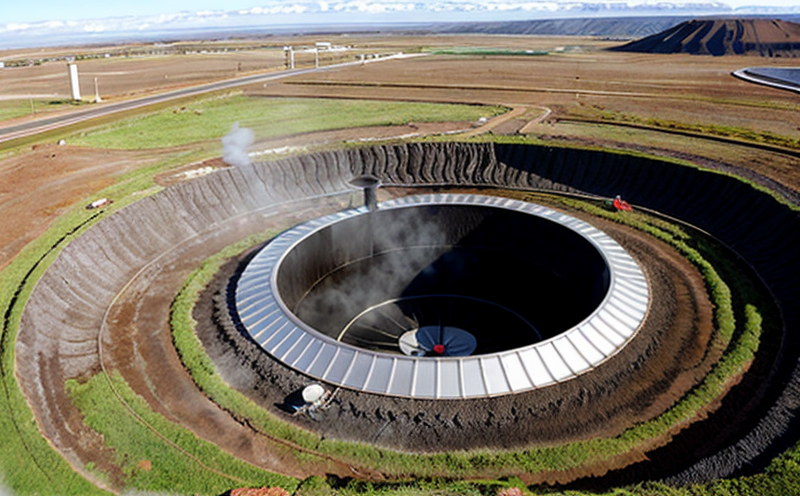ASTM D512 Chloride Content Testing in Geothermal Fluids
The ASTM D512 method is a critical tool used by laboratories to measure chloride content in geothermal fluids. This testing is particularly important for the energy and renewable energy sectors, especially within geothermal energy systems. Chlorides play a significant role in the performance and longevity of geothermal equipment as they can lead to corrosion if not properly managed.
The primary purpose of this test is to ensure that chlorides are maintained at acceptable levels which prevent the degradation of infrastructure. The method involves dissolving the sample, usually geothermal fluid, in nitric acid followed by titration against silver nitrate solution using potassium chromate as an indicator. This technique allows for accurate determination of chloride ion concentration.
Quality managers and compliance officers rely on ASTM D512 testing to meet regulatory requirements ensuring safe operation of geothermal plants. R&D engineers use the results from this test during development phases to optimize system designs against potential corrosive effects caused by chlorides. Procurement teams also benefit as they can select appropriate materials resistant to chloride-induced corrosion.
The standard procedure for sample preparation includes filtering and diluting the collected fluid according to specified ratios. It’s essential that all equipment used adheres strictly to ASTM guidelines to avoid any discrepancies in results. Understanding these nuances helps stakeholders make informed decisions regarding maintenance schedules, material selection, and operational parameters.
Regular monitoring of chloride levels through ASTM D512 testing ensures compliance with industry standards like ISO 9223:2016 for water from geothermal sources used in power generation. Compliance officers can leverage this information to stay ahead of potential violations which could impact both business operations and reputation.
For instance, a high chloride concentration might indicate issues such as seawater intrusion into the well or improper treatment processes. By identifying these problems early on, operators can implement corrective measures before they escalate into more serious issues affecting production efficiency. This proactive approach not only enhances operational sustainability but also contributes towards reducing environmental impacts associated with geothermal energy projects.
In summary, ASTM D512 chloride content testing is an indispensable part of maintaining efficient and environmentally responsible geothermal operations. Its role extends beyond just compliance; it serves as a vital tool for optimizing performance while safeguarding against costly repairs due to material failures resulting from excessive chloride levels.
Applied Standards
The ASTM D512 method is widely recognized and utilized in various industries including geothermal energy systems. This standard specifies the procedure for determining the concentration of chlorides in water by titration with silver nitrate solution. The methodology ensures accurate results that are crucial for ensuring proper management and maintenance of geothermal facilities.
- ASTM D512: Standard Practice for Chloride Content of Water by Titration
- ISO 9223:2016 - Specification and methods for water from geothermal sources used in power generation
The application of these standards guarantees consistency across different laboratories performing similar tests, thereby enhancing reliability and comparability of data. Compliance with such international norms is essential not only for maintaining high quality but also ensuring adherence to global best practices.
Benefits
- Promotes Safe Operation: Ensures that chloride levels remain within safe limits preventing potential risks associated with excessive corrosion.
- Enhances Efficiency: By identifying and addressing early signs of issues, operations can be optimized leading to improved overall efficiency.
- Safeguards Reputation: Compliance with recognized standards helps build trust among stakeholders enhancing corporate image.
- Reduces Costs: Early detection of problems saves money on repair costs by implementing preventive maintenance strategies.
In addition to these tangible benefits, regular monitoring through ASTM D512 testing contributes significantly towards sustainable practices within the geothermal sector. This approach aligns with broader environmental goals while supporting long-term viability of energy projects.
Why Choose This Test
- Accurate Results: Utilizing ASTM D512 ensures precise measurements which are vital for effective decision-making processes.
- Regulatory Compliance: By adhering to this standard, organizations can ensure their practices meet all necessary legal requirements.
- Industry Reputation: Demonstrating commitment to quality control measures like ASTM D512 enhances the company’s standing among peers and clients alike.
- Proactive Approach: Taking steps early in the process helps avoid more significant problems later down the line saving both time and resources.
The benefits of choosing ASTM D512 chloride content testing extend far beyond simple compliance. It provides valuable insights into operational conditions allowing for informed decisions that maximize efficiency while minimizing unnecessary expenses.





